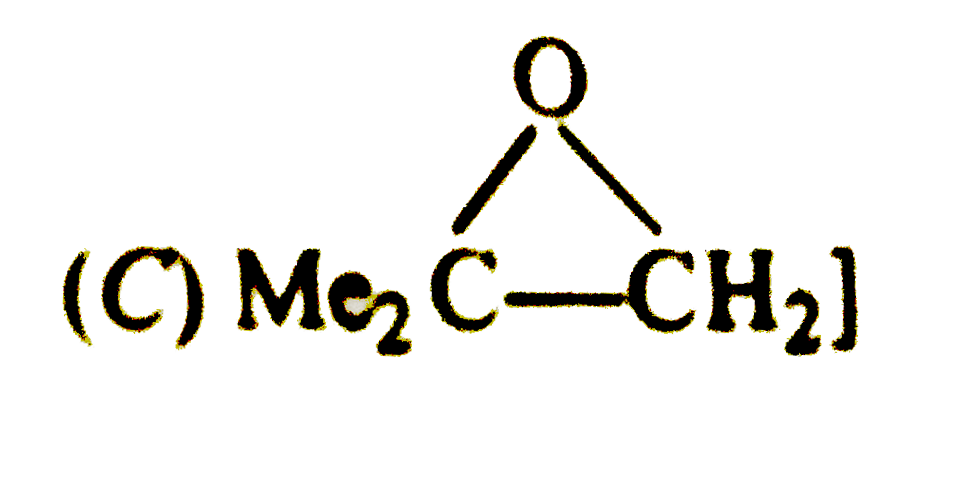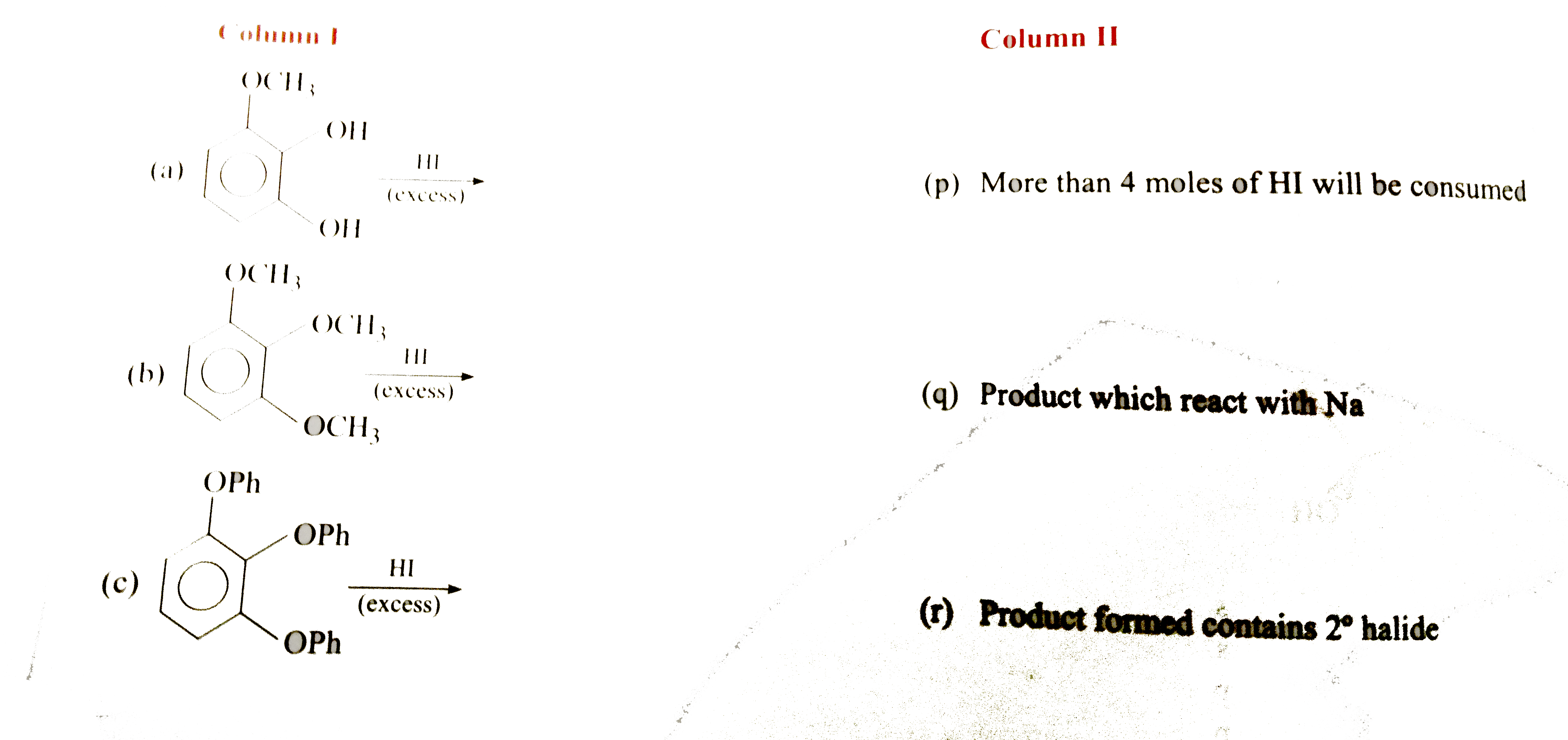Complete Solutions to ETHERS of chapter ALCOHOLS, PHENOLS AND ETHERS of Class 12 book with complete answers and questions
| Class 12 | CHEMISTRY |
| Chapter | ALCOHOLS, PHENOLS AND ETHERS |
| OP TANDON | ETHERS |
| Number Of Questions | 33 |
| Academic Year | 2023-24 |
Give the common and IUPAC names of the following ethers `:`
(i)` (CH_(3))_(2)CH-O-CH(CH_(3))CH_(2)CH_(3)`
(ii) `ClCH_(2)CH_(2)-O-CH_(3)`
(iii) `CH_(3)-O-CH=CH_(2)`
(iv) `p-NO_(2)C_(6)H_(5)-O-C_(2)H_(5)`
View SolutionWhat happens when ?
(a) Ethyl bromide reacts with sodium ethoxide.
(b) Ethyl alcohol is heated with conc. `H_(2)SO_(4)` at 413 K .
(c ) The vapours of ethyl alcohol are passed over anhydrous alumina at 523K.
(d) Diethyl ether is heated with phosphorus pentachloride.
(e ) Ethyl iodide is heated with dry oxide.
(f) Ether is heated with hydroiodic acid.
(g ) Ether i sheated with conc. `H_(2)SO_(4)`.
[See the preparation and properties of diethyl ether. ]
View SolutionHow will you distinguish between ?
(i) Diethyl ether and n-butane (alkane).
(ii) Diethyl ether and but-1-ene(an alkene).
(iii) Diethyl ether and alcohol (primary).
(iv) An ether and alkyl bromide.
View SolutionSupply structural formulae for missing compounds.
(i) `H_(2)C=CH_(2)+(A) rarr ClCH_(2)-CH_(2)OH underset(413K)overset(H_(2)SO_(4))(rarr) (B) underset(Delta)overset("alc. KOH")(rarr) (C )`
(ii) `CH_(3)CHBrCH_(3)overset("alc. KOH")(rarr)(A)underset("Peroxide")overset(HBr)(rarr)(B)overset(CH_(3)ONa)(rarr)(C )`
(iii) `Me_(3)CBroverset("alc. KOH")(rarr)(A) overset(HOCl)(rarr) (B) overset(NaOH)(rarr)(C )`

View SolutionGive reason for the following `:`
`(i) (CH_(3))_(3)C-O-CH_(3)underset("ether")overset('Anhydrous HI")(rarr) CH_(3)I+(CH_(3))_(3)COH`
(ii) `(CH_(3))_(3)C-O-CH_(34)overset(HI(aq.))(rarr)(CH_(3))_(3)Cl+CH_(3)OH`
(iii) Ethers possess a net dipole moment even if they are symmetrical in structure.
(iv) Dimethyl ether is completely miscible with water but diethyl ehter is soluble in water to a small extent.
(v) The C-O-C bond angle in ether is higher than H-O-H angle in water though oxygen is `sp^(3)-` hybridized in both these cases.
(vi) Why are ethers relativelyinert compounds ?
View Solution(a) Discuss the structural relationship of water , alcohol and ethers.
(b) Compare the bond angles of `H-O-H,C-O-H` fo alcohol and `C-O-C` of ethers.
(c ) What is crown ether ? How is it named ?
9d) What is absolute ether ?
(e ) Compare the following alkyl halides in decreasing order of reactivity in the Williamson's reaction `:`
`ClCH_(2)CH_(2)CH_(3)(A)," "BrCH_(2)CH_(2)CH_(3)(B),`
`(CH_(3))_(3)C C H_(2)Br(C )," "ClCH_(2)CH=CH_(2)(D)`
(f) Give six types of ethers and cannot be synthesised by the typical Williamson's reaction.
View SolutionAccount for the following `:`
(i) Ethers have significant dipole moments.
(ii) Ethers have lower boiling points than the corresponding isomeric alcohols but approximately equal to a paraffin with similar molecular mass structure.
(iii) HI is better reagent than HBr for cleavage of ethers.
(iv) Why a non-symmetrical ether is not prepared by heating a mixture of ROH and R'OH in acid ?
(v) Why is it possible to prepare tertiary butyl ethyl ether in good yield by heating tertiar butanol and ethanol ?
(vi) Ether are soluble in conc. `H_(2)SO_94)` but ethers separate out from the solution on addition of water.
(vii) Why id diethyl ether used as a solvent for (i) `BF_(3)` and (ii) RMgBr ?
(viii) Sometimes explosion occrs during distillation of an ether sample.
(ix) Why `[(CH_(3))_(3)C]_(2)O` cannot be prepared either by Williamson's reaction or by dehydration of tertiary butyalcohol ?
(x) Why ArO-R ethers are clearved with HI to give RI and ArOH rather than ArI and R-OH ?
(xi) Which of the following is the correct method for synthesising methyl tert-butyl ether and why ?
(a) `(CH_(3))_(3)C-Br+NaOMe rarr`
`(b) CH_(3)+NaO -T-Bu rarr`
(xii) 2,2-Dimethyl oxirane can be cleaved by acid `(H^(+))` . Write mechanism.
(xiii) Write the equations of the reaction of hydrogen iodide with `:`
(i) 1-Propoxypropane (ii) Methyoxybenzene
9iii) Benzyl ethyl ether
View SolutionAnswer the following `:`
(i) What is the synthetic utility of the reaction `RMgX` or Rli with ethylene oxide ?
(ii) How is di-tert-butyl ether synethsised ?
(iii) What product is formed when, `HOCH_(2)CH_(2)CH_(2)OH` is heated with conc. `H_(2)SO_(4)` ?
(iv) The following reaction gives two product. Write the structures of the products .
`(CH_(3))_(2)CH-O-CH_(3)underset(Delta)overset("HI(excess)")(rarr)`
(v) What would be major product in the following reaction ?
`CH_(3)-underset(CH_(3))underset(|)overset(CH_(3))overset(|)(C)-CH_(2)Brunderset(Delta)overset(C_(2)H_(5)ONa//C_(2)H_(5)OH)(rarr)`
(vi) Sodium metal can be used for drying diethyl ether but not ethanol.
(vii) What products are obtained when `:`
(viii) Di tert-butyl ether cannot be obtained by Williamson's synthesis.
(ix) A mixture of ethyl alcohol and n-propyl alcohol on treatment with conc. `H_(2)SO_(4)` gives a mixture of three ethers.
(x) Ethers can be cleaved only by acids and not by bases.
(xi) Predict the product of the follwowing reaction `:`

(xii) The following is not an appropriate reaction for the preparation of tert-butyl ethyl ether.
`CH_(3)-underset(CH_(3))underset(|)overset(CH_(3))overset(|)(C)-Cl+NaOC_(2)H_(5)rarr CH_(3)-underset(CH_(3))underset(|)overset(CH_(3))overset(|)(C)-C_(2)H_(5)`
(a) What would be the major product of this reaction ?
(b) Write a suitable reaction for the preparation of tert-butyl ethyl ether.
(xiii) How is 1-propoxypropane synthesized from propan-1-ol? Write mechanism of this reaction.
View SolutionHow would you bring the following conversions ?
(i) Ethyl alcohol to diethyl ether.
(ii) Diethyl ether to ethyl alcohol.
(iii) Ethyl iodide to diethyl ether.
(iv) Diethyl ether to ethyl iodide.
(v) Methyl iodide to methyl ethyl ether.
View SolutionGive the major product formed by heating the following ethers with conc. HI and mentioning `S_(N^(1))` or `S_(N^(2))` mechanism.
(i) `C_(6)H_(5)-O-CH_(3)`(Methoxybenzene)
(ii) `C_(6)H_(5)CH_(2)-O-C_(2)H_(5)`(Benzyl ethyl ether)
(iii) `C_(6)H_(5)CH_(2)-O-C_(6)H_(5)`(Benzyl phenyl ether)


View SolutionWrite the names of reagents and equations for the preparation of following ethers by Williamson's synthesis `:`
(i) 1-Methyoxypropane (ii) 2-Ethoxy-2-methylpropane
(iii) Ethoxybenzene
View SolutionCompound (A) `C_(4)H_(10)O`, is found to be soluble in sulphuric acid . (A) does not react with sodium or potassium permanganate. When (A) is heated with excess of HI, it is converted into a single alkyl halide. What is (A) ?
View SolutionA neutral compound (A) having C,H and O, on refluxing with HI yields methyl iodide and an alkyl iodide (B), which contains 74.6 per cent iodine. (B) when treated with moist `Ag_(2)O` produces a prodcut which undergoes the haloform reaction. Characterize (A), what would have been produced if (B) were treated with dry `Ag_(2)O` ?
View Solution(A) Ether behaves as bases in the presence of mineral acids.
(R ) Due to the presence of lone pair of electrons on oxygen.
View Solution(A ) The boiling point of ethanol is much higher than that of diethyl ether.
(R ) In ethanol, the molecules are associated due to inter-molecular hydrogen bonding, whereas in diethyl ether it is not possible.
View Solution(A) Phenetole on clearvage with HI yields phenol and ethyl iodide
(R ) Phenetole is a mixed aromatic ether.
View SolutionAssertion: Anisole undergoes eletctrophilic substitution at `o-`and `p-`positions.
Reason: Anisole is less reactive than phenol towards electrohphilic substitution reactions.
View Solution(A) With HI, anisole forms iodobenzene and methyl alcohol.
(R ) `I^(-)` ion will combine with smaller group to avoid steric hindrance.
View Solution(A) tert-Butyl methyl ether on cleavage with HI at 373K gives tert-butyl iodide and methanol.
(R ) The reaction occurs by `S_(N^(2))` mechanism.
View Solution(A) The `C-O-C` bond angle in ethers is higher than H-O-H bond angle in water.
(R ) Oxygen is `sp^(3)`- hybridized in both ethers and water.
View Solution(A) tert-Butyl alcohol on heating with conc. `H_(2)SO_(4)` at 413K gives 2-methyl propene as the main product and not di-tert-butyl ether.
(R ) All alcohols are readily dehydrated with conc. `H_(2)SO_(4)`.
View Solution(A) 1-Bromo-2,2-dimethyl propane on heating with ethanol gives 2-ethoxy-2-methyl butane as the main product.
(R ) The reaction occurs by `S_(N^(2))` mechanism.
View SolutionAssertion. `t`-Butyl Methyl ether is not prepared by the reaction of `t-`butyl bromide with sodium methoxide.
Reason: Sodium methoxide is a strong nucleophile.
View Solution(A) Oxirane are cleaved under acidic and basic conditions.
(R ) The oxirane ring is strained and the tetrahedral bond angle `(109.5^(@))` is distorted t0 `61.5^(@)`.
View Solution(A) Diphenyl ether is prepared by Ulmann reaction as shown below `:`
`C_(6)H_(5)ONa+BrC_(6)H_(5)underset(483K)overset(Cu)(rarr)C_(6)H_(5)-O-C_(5)H_(5)+NaBr`
(R ) Diphenyl ether is used as perfume.
View SolutionMatch the following `:`

View SolutionMatch the following `:`

(d) `HOCH_(2)CHOHCH_(2)OH underset(("excess"))overset(HI)(rarr)" "(s) CH_(3)I "is one of the product" `
View SolutionMatch the following `:`

View SolutionHow many of the following ethers can not be prepared by Williamson's synthesis ?
`CH_(3)-O-CH_(2)CH_(3),(C_(2)H_(5))_(2)O,(CH_(3))_(3)C-O-CH_(3),(CH_(3))_(3)C-O-CH_(2)CH_(3),(CH_(3))_(3)C-O-C(CH_(3))_(3), C_(6)H_(5)-O-CH_(3),C_(6)H_(5)-O-CH_(2)CH_(3),(C_(6)H_(5))_(2)O,C_(6)H_(5)CH_(2)-O-C_(6)H_(5)`
View SolutionHow many mole of 'HI' will react with

View SolutionHow many of the following ethers can be synthesised by typical Williamson's reaction ?
`R_(2)CH-O-CHR_(2),R_(3)C-O-CR_(3),R_(3)C-O-CHR_(2),C_(6)H_(5)-O-C_(6)H_(5),RCH=CH-O-CH=CHR',R_(3)C CH_(2)-O-CH_(2)CR_(3)`
View SolutionTotal number of the following ethers that can be prepared by Williamson synthesis is `:`
`C_(6)H_(5)CH_(2)OC_(6)H_(5),C_(6)H_(5)OC_(6)H_(5),(CH_(3))_(3)COCH_(2)CH_(3),(CH_(3))_(3)COC(CH_(3))_(3),C_(6)H_(5)OCH_(2)CH_(3),CH_(3)OCH_(2)CH_(3)`
View SolutionExamine the structural formulas shown below and identify how many compounds will show coupling reaction with diazonium salts faster than ansiole

View Solution
ETHERS questions and complete solutions for chapter ALCOHOLS, PHENOLS AND ETHERS of G.R. BATHLA & SONS CHEMISTRY (HINGLISH) of Class 12
All Exercises from OP TANDON Class 12 CHEMISTRY ALCOHOLS, PHENOLS AND ETHERS
- (C )ETHERS
- ASSERTION-REASON
- BRAI STORMING PROBLEMS
- ETHERS
- ETHERS Passage 6
- Ethers SET1:
- ILLUSTRATION OF OBJECTIVE QUESTINS
- LINKED COMPREHENSION Passage 1
- Matching Type
- MATRIX -MATCH
- OBJECTIVE QUESTIONS (LEVEL-A)
- OBJECTIVE QUESTIONS (LEVEL-B)
- passage 2
- Passage 3
- Passage 4
- Passage 5
- Passage 7
- PHENOLS
- PROBLEM
- PROBLEM FOR PRACTICE
- PROBLEMS BASED ON STRUCTURE AND PROPERTIES
- SET II
- SETII
- SINGLE INETER ANSWER TYPE QUESTIONS / ALCOHOLS AND PHENOLS
- Some SOLVED PROBLEMS